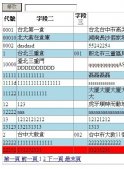一、资源文件
资源文件顾名思义就是存放资源的文件。资源文件在程序设计中有着自身独特的优势,他独立于源程序,这样资源文件就可以被多个程序使用。同时在程序设计的时候,有时出于安全或者其他方面因素的考虑,把重要东西存放在资源文件中,也可以达到保密、安全的效果。那么Visual C#所使用的资源文件中到底存放哪些东西呢?在用Visual C#创建资源文件大致可以存放三种类型的数据资源,分别是字节数组、各种对象和字符串。本文将结合一个程序例子来具体说明用Visual C#是如何创建资源文件的。
二、创建资源文件所用的类
在.Net FrameWork SDK中的一个名字叫System.Resources名称空间,在此名称空间中为应用程序提供了许多创建、存储和使用资源文件的类和接口。其中有一个类叫ResourceWriter,Visual C#就是通过调用这个类来实现创建、存储资源文件的。
三、创建资源文件的方法
首先要继承一个ResourceWriter类,然后调用ResourceWriter类的一个方法Generate ( ),就可以产生一个资源文件了。具体语句如下:
ResourceWriter rw = new ResourceWriter ( "My.resources" ) ;
rw.Generate ( ) ;
此时在磁盘的中就会产生一个名称为"My.resources"的资源文件,但此时的资源文件没有任何内容,下面我们就来看看如何往资源文件中添加资源。
四、往资源文件中添加资源的方法
在ResourceWriter类中提供了一个AddResource ( )方法,这个方法的作用就是往资源文件中添加资源的。在Visual C#中对不同的资源有着不同的加入方式。
(1).加入字节数组,语法格式为:
public void AddResource ( string , byte [ ] ) ;
注释:其中string是在使用资源文件的时候,此字节数组在程序中的的唯一标识符
(2).加入对象,语法格式为:
public void AddResource ( string , object );
注释:其中string是在使用资源文件的时候,此对象在程序中的唯一标识符。如:
复制代码代码如下:
Image image1 = Image.FromFile ("abc1.jpg") ;
Image image2 = Image.FromFile ( "abc2.jpg" ) ;
rw.AddResource ( "abc1" , image1 ) ;
rw.AddResource ( "abc2" , image2 ) ;
(3).加入字符串,具体语法如下:
public void AddResource ( string1 , string2) ;
注释:其中string1是在使用资源文件的时候,此字符串在程序中的唯一标识符在本文的程序中,是如此使用的:
rw.AddResource ( "MyStr" , "从资源文件中读取字符串!" );
至此我们已经创建了一个资源文件,并且在资源文件中加入了若干个资源,当然在这之后,还应该注意,保存此资源文件,并关闭资源文件,具体如下:
rw.Close ( ) ;
五、示例创建资源文件
在这里创建一个什么样的工程好呢?有些朋友可能会用.net创建一个“控制台应用程序”,其实没必要,直接用记事本创建一个CS文件就可以了,假如名称为:CreatResources.cs。编译命令:csc CreatResources.cs;运行:CreatResources。这时会产生一个叫做My.resources的资源文件。先放到这里,等下再用。
复制代码代码如下:
using System ;
using System.Drawing ;
using System.Resources ;
class CreatResource
{
public static void Main ( )
{
ResourceWriter rw = new ResourceWriter ( "My.resources" ) ;
Image image1 = Image.FromFile ("abc1.jpg") ;
Image image2 = Image.FromFile ( "abc2.jpg" ) ;
rw.AddResource ( "abc1" , image1 ) ;
rw.AddResource ( "abc2" , image2 ) ;
Icon ic = new Icon("CDDRIVE.ICO");
rw.AddResource( "abc3",ic);
rw.AddResource( "abc4","这是从资源文件中读出的字符");
rw.Generate ( ) ;
rw.Close ( ) ;
}
}
六、将生成的资源文件添加测试工程中的方法
创建一个“Windows应用程序”测试工程,将My.resources资源文件添加到该工程中,步骤如下:
1,在资源管理器里选中文件
2,按住鼠标左键,拖到工程文件上,松开鼠标左键。
3,在拖放的文件上点鼠标右键,选“属性”
4,在生成操作里选择“嵌入的资源”。
七、如何在程序中管理资源文件中的资源
在.Net FrameWork SDK这提供了一个关于资源文件创建和使用的名称空间--System.Resources。在这个名称空间中有一个Class为ResourceManager,这个Class的主要作用就是管理并使用资源文件。Visual C#是通过这个类来管理并使用嵌入程序中的资源文件中的资源。下列代码就是定义一个ResourceManager类来管理嵌入程序资源文件中的资源:
ResourceManager rm = new ResourceManager ( " Res.My " , Assembly.GetExecutingAssembly ( ) ) ;
注意:ResourceManager rm = new ResourceManager ( " Res.My " , Assembly.GetExecutingAssembly ( ) ) ;语句中,构造函数的第一个参数Res.My 由两部分构成,Res表示测试工程的命名空间,My表示资源文件名My.resources的根名称,即点号有前部分My。
八、如何在程序中使用资源文件中的资源
使用了AddResource ( )方法来加入资源,他的语法中的第一个参数是用户可以定义的字符串,这个字符串就是资源在资源文件的唯一标识,在程序设计中,就是通过这个唯一标识符来使用某个资源的。那么如何在程序中通过这个标识符来得到所需资源?这就要使用到ResourceManager类中的GetObject()和GetString()方法。这二个方法作用是获得指定的资源。下面是这二个方法的语法:
object GetSting(String)
object GetObject(String)
其中的"String"就是资源在资源文件中的那个唯一标识符。细心的读者可能已经注意到,这二个方法的返回值都是一个Object类型的变量,也就是一个参考类型的变量,而在程序中的字符串或者图象等,是一个实值类型变量。这就需要进行转换,而这种转换就是上面所说的装箱和出箱。下列代码是从资源文件中提取字符串、图象和图标资源:
提取字符串资源:
String s = ( ( String ) rm.GetString ( "MyStr" ) ) ;
提取图标资源:
Icon icoDemo = ( ( Icon ) rm.GetObject ( "demo.ico" ) ) ;
提取图象资源:
Image a = ( ( Image ) ( rm.GetObject ( "ok-off.png" ) ) ) ;
九、测试工程源代码
复制代码代码如下:
using System;
using System.Drawing;
using System.Collections;
using System.ComponentModel;
using System.Windows.Forms;
using System.Data;
// 加入以下两个命名空间。
using System.Resources;
using System.Reflection;
namespace Res
{
///
/// Form1 的摘要说明。
///
public class Form1 : System.Windows.Forms.Form
{
private System.Windows.Forms.PictureBox pictureBox1;
private System.Windows.Forms.Button button1;
private System.Windows.Forms.Button button2;
private System.Windows.Forms.Button button3;
private System.Windows.Forms.Label label1;
private System.Windows.Forms.Button button4;
///
/// 必需的设计器变量。
///
private System.ComponentModel.Container components = null;
public Form1()
{
//
// Windows 窗体设计器支持所必需的
//
InitializeComponent();
//
// TODO: 在 InitializeComponent 调用后添加任何构造函数代码
//
}
///
/// 清理所有正在使用的资源。
///
protected override void Dispose( bool disposing )
{
if( disposing )
{
if (components != null)
{
components.Dispose();
}
}
base.Dispose( disposing );
}
#region Windows 窗体设计器生成的代码
///
/// 设计器支持所需的方法 - 不要使用代码编辑器修改
/// 此方法的内容。
///
private void InitializeComponent()
{
this.pictureBox1 = new System.Windows.Forms.PictureBox();
this.button1 = new System.Windows.Forms.Button();
this.button2 = new System.Windows.Forms.Button();
this.button3 = new System.Windows.Forms.Button();
this.label1 = new System.Windows.Forms.Label();
this.button4 = new System.Windows.Forms.Button();
this.SuspendLayout();
//
// pictureBox1
//
this.pictureBox1.BorderStyle = System.Windows.Forms.BorderStyle.FixedSingle;
this.pictureBox1.Location = new System.Drawing.Point(8, 8);
this.pictureBox1.Name = "pictureBox1";
this.pictureBox1.Size = new System.Drawing.Size(256, 240);
this.pictureBox1.SizeMode = System.Windows.Forms.PictureBoxSizeMode.StretchImage;
this.pictureBox1.TabIndex = 0;
this.pictureBox1.TabStop = false;
//
// button1
//
this.button1.Location = new System.Drawing.Point(280, 8);
this.button1.Name = "button1";
this.button1.Size = new System.Drawing.Size(88, 24);
this.button1.TabIndex = 1;
this.button1.Text = "图像1";
this.button1.Click += new System.EventHandler(this.button1_Click);
//
// button2
//
this.button2.Location = new System.Drawing.Point(280, 48);
this.button2.Name = "button2";
this.button2.Size = new System.Drawing.Size(88, 24);
this.button2.TabIndex = 2;
this.button2.Text = "图像2";
this.button2.Click += new System.EventHandler(this.button2_Click);
//
// button3
//
this.button3.Location = new System.Drawing.Point(280, 128);
this.button3.Name = "button3";
this.button3.Size = new System.Drawing.Size(88, 24);
this.button3.TabIndex = 2;
this.button3.Text = "文字";
this.button3.Click += new System.EventHandler(this.button3_Click);
//
// label1
//
this.label1.Location = new System.Drawing.Point(8, 264);
this.label1.Name = "label1";
this.label1.Size = new System.Drawing.Size(360, 16);
this.label1.TabIndex = 4;
this.label1.Text = "label1";
//
// button4
//
this.button4.Location = new System.Drawing.Point(280, 88);
this.button4.Name = "button4";
this.button4.Size = new System.Drawing.Size(88, 24);
this.button4.TabIndex = 2;
this.button4.Text = "图标";
this.button4.Click += new System.EventHandler(this.button4_Click);
//
// Form1
//
this.AutoScaleBaseSize = new System.Drawing.Size(6, 14);
this.ClientSize = new System.Drawing.Size(376, 285);
this.Controls.Add(this.label1);
this.Controls.Add(this.button2);
this.Controls.Add(this.button1);
this.Controls.Add(this.pictureBox1);
this.Controls.Add(this.button3);
this.Controls.Add(this.button4);
this.Name = "Form1";
this.Text = "Form1";
this.ResumeLayout(false);
}
#endregion
///
/// 应用程序的主入口点。
///
[STAThread]
static void Main()
{
Application.Run(new Form1());
}
private void button1_Click(object sender, System.EventArgs e)
{
System.Resources.ResourceManager rm = new ResourceManager("Res.My",Assembly.GetExecutingAssembly());
this.pictureBox1.Image = (Bitmap)rm.GetObject("abc1");
}
private void button2_Click(object sender, System.EventArgs e)
{
System.Resources.ResourceManager rm = new ResourceManager("Res.My",Assembly.GetExecutingAssembly());
this.pictureBox1.Image = (Bitmap)rm.GetObject("abc2");
}
private void button4_Click(object sender, System.EventArgs e)
{
System.Resources.ResourceManager rm = new ResourceManager("Res.My",Assembly.GetExecutingAssembly());
this.Icon = (Icon)rm.GetObject("abc3");
}
private void button3_Click(object sender, System.EventArgs e)
{
System.Resources.ResourceManager rm = new ResourceManager("Res.My",Assembly.GetExecutingAssembly());
this.label1.Text = rm.GetString("abc4");
}
}
}














